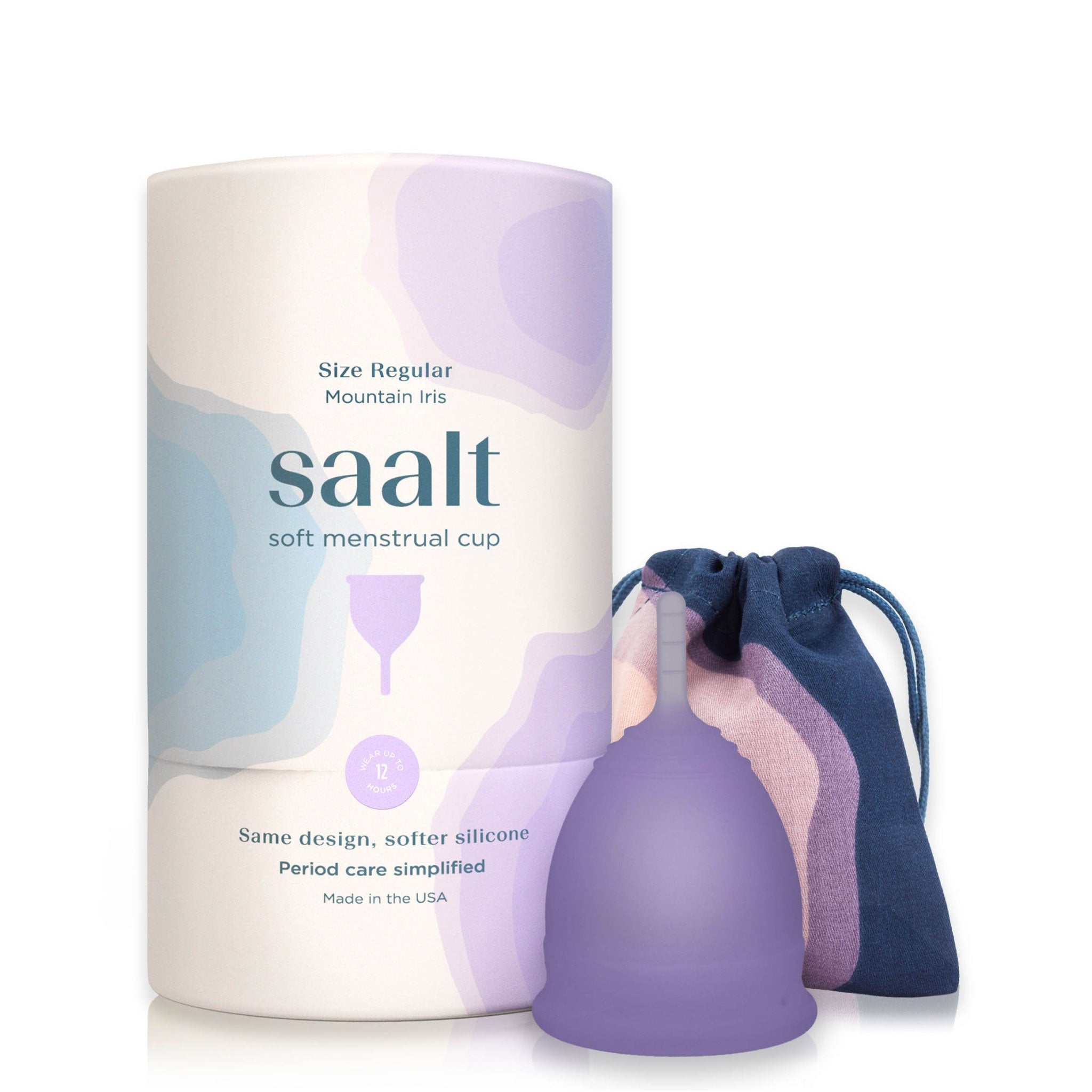Let’s face it—getting your period can be a hassle. Between tampons, pads, and constant worry about leaks or discomfort, it can feel like there’s no perfect solution. That’s why menstrual cups and menstrual discs have been getting a lot of buzz lately. These eco-friendly, low-waste alternatives are becoming more popular, but if you're thinking about making the switch, you're probably wondering: Do they hurt? Learn: Is a disposable menstrual disc or a reusable disc right for me?
So, What Are Period Cups and Discs?
Menstrual cups are small, flexible, bell or V-shaped devices made of medical-grade silicone. They are inserted into the vaginal canal and collect menstrual fluid, rather than absorbing it. Period cups stay in place by the natural grip of your vaginal muscles as well as some gentle suction. You can wear a cup for up to 12 hours before needing to empty it, clean it, and pop it back in.
Menstrual discs are a little different. These are circular, dome-shaped flexible discs that sit higher in the vaginal fornix and encircle your cervix. Like cups, they also collect menstrual blood, but they’re a bit flatter in shape and are designed to provide a snug fit by being held in place behind your pubic bone. Unlike a cup for periods, discs don’t rely on suction or your pelvic floor muscles. You can wear a disc for up to 12 hours as well, then remove, empty, clean, and reinsert.
Both products are a solid option for those who want something sustainable, effective, and subtle over pads or tampons, but you’re probably wondering if they’ll feel comfortable to wear.
Do Period Cups and Discs Hurt?
In most cases, no, they shouldn’t hurt or cause any discomfort. When inserted and positioned correctly, both menstrual cups and menstrual discs shouldn’t even feel like they are there. However, it can sometimes take a little trial and error to get it right. So, if you’re feeling some discomfort, don’t panic! It’s not a sign that these products won’t work for you. It just means that you may need to adjust your placement or try a different size or softness.
1. Proper Period Cup or Menstrual Disc Insertion
One of the biggest reasons people experience discomfort with a period cup or disc is incorrect insertion. You want to make sure you’re putting it in the right spot, and if it isn’t, then your body will usually let you know. To start, it always helps to be comfortable and relaxed for insertion as anxiety often causes us to tighten up our pelvic floor. So begin by taking a few deep breaths, and don’t rush the process. If you find that you are feeling a bit of friction when trying to insert your cup or disc, then wet it with warm water or add a couple drops of silicone-safe water-based lubricant.
Once inserted, if a menstrual cup isn't positioned and sealed correctly, then it can sometimes put pressure on your cervix. This can feel like a bit of extra cramping or a bit of pressure. Not to worry, though; just pinch the base of the cup and wiggle it down a tad. Then, once in a comfortable spot, check to be sure that your cup is fully open and sealed.
Similarly, if a disc isn’t positioned high enough, then it can feel like noticeable pressure or like your disc is about to come out. If that’s the case, just push it up a bit higher. Using your thumb can really help with getting it in the optimal position. If your menstrual disc isn't fully encircling your cervix but rather bumping up against it, then you may notice a cramping feeling too. Again, just take a deep breath and do a little readjusting until it feels right. It’s normal for it to take some trial and error as you learn more about your anatomy and what feels best for you. But, over time, you’ll get the hang of it, and it’ll feel like second nature.
2. Period Cup & Disc Size and Fit Matter
Just like tampons, menstrual cups and discs come in different sizes. But, where they differ a bit is that, unlike tampons, the size is more dependent on your anatomy rather than your flow. And just finding your favorite jeans, finding the right size for your body is super important. Most people can easily wear either size cup or disc comfortably, but it can help to try a couple sizes to see what works best for you! This is why we offer our duo sets here at Saalt, like our Disc Duo and Cup Duo, so you can have both on hand to try. Many people additionally find that different sizes work best throughout their period. It’s good to have options, after all!
Here are some of the main things to consider when it comes to finding your perfect size:
-
Cervix height while on your period: If you're unsure of your cervix height, check out our video to learn: How to measure your cervix height. Generally, a higher cervix calls for a regular-sized cup or disc, whereas a shorter cervix should find a better fit with a small cup or disc.
-
Experience: Are you newer to using insertable products? Start small with our Saalt Teen Cup or Small Disc.
-
Have you given birth?: Oftentimes, a postpartum user will find that the regular cup or disc is the best fit. But keep in mind that everybody is different.
3. Your Body’s Sensitivity
Everyone’s body is unique, and some people just have more sensitive spots. For some, using a menstrual cup or disc can feel a bit like having something foreign in there, especially if you’re not used to it. It could cause some discomfort, but this doesn’t mean it’s a “bad” product for you. For some people, it can just take a little more time for their bodies to adjust to the feeling of having a cup or disc inserted and over time, it should feel more and more comfortable.
For some, bladder sensitivity can be a factor as well. If you find that you feel pressure on your bladder or urethra or have a difficult time urinating while using your menstrual cup or disc, then this usually just means that a softer product should do the trick for you. Our Saalt Soft Cup is thinner and more flexible, specially designed for those with pressure sensitivities like these in mind.
Tips for Reducing Cup or Disc Insertion Discomfort
-
Take your time & do your best to relax: Insertion is key. Don’t rush it. Give yourself some time to practice at home first so you can feel comfortable testing out different techniques. Start with some deep breathing to relax your pelvic floor and take your time with it.
-
Find the right size: Make sure you’re using the right size for your body. If you’re not sure, you can always try a smaller or larger size until you find the one that fits best.
-
Try different folds and angles: When using a menstrual cup, experiment with different folds to see which one is easiest for you to insert. All vaginas are different after all! For discs, make sure you’re placing it at the right angle and tucking it far enough behind your pubic bone.
-
Use a little lubricant: If you’re struggling with dryness or tightness, a small amount of water-based lubricant can make things easier.
Bottom Line
For most people, period cups and discs do not hurt. In fact, once you figure out how to use them, people often mention not feeling their cup or disc at all. But if you do experience pain or discomfort, don’t stress! There’s often a simple fix, whether that’s adjusting the size, trying a different product, or just getting a little more practice. Of course, you know your body best, so be sure to listen to it and check in with yourself about what is working or not working for you.
Plus, you never have to feel alone in this. Reach out to our Saalt Coaches at [email protected] if you are struggling and need some help. They’ve been there and done that, so they get it. 💖 Or, you can also look for menstrual cup or disc communities online for support too. We’re partial to the Saalt Cup Academy on Facebook if you are looking for recommendations.
At the end of the day, menstrual cups and discs can be game-changers for managing your period in a sustainable and comfortable way. It just takes a bit of trial and error to get it right for your body.





